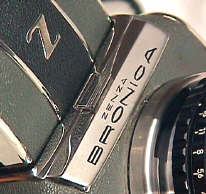 Bronica D
Bronica DHome Camera Articles FOR SALE Orders I Buy / Wants Repairs Books Adapters
 Bronica D
Bronica D
Wonderful, vastly under-rated Japanese 2 1/4 SLR
The 1959 Bronica was Japan's answer to the Hasselblad, and a great answer it was, too. After careful examination of both period cameras, I have come to the opinion that the unheralded Bronica actually had a better fit and finish than Hasselblad's original focal planed shuttered efforts, the 1600F and 1000F! The Bronica also shows design innovation and many improvements on the basic Hassy idea, the best of which might be the instant return mirror and automatic diaphragm. So far as I know, these were Bronica firsts for 120 format.
The pics really don't do the camera justice. The Bronica D is simply beautiful, a work of mechanical art in the 2 1/4 world. It is also very rare, the first I have even seen after what seems like three million camera shows. Estimated production for the original Zenza and the Bronica D is in the two to four thousand range. The level of precision can't come across in the pics. The controls snap with a precision fit which is a delight.
I found myself quite surprised by the camera. Nothing I had read, including the contemporary reports of the day, really emphasize the immaculate quality, the fit and finish and the craftsmanship. The workmanship is really beautiful, a jewel. The pride in design and construction is very obvious. The camera is covered in a handsome two tone dark/light gray.
The "chrome" on the body is actually stainless steel, a very nice touch. The early 1600f Hasselblad influence is obvious and unmistakable. Both have a similar body design with interchangeable finders, lenses, and back. A nice feature is that inserting a dark slide automatically detaches the back.
Focal plane shutter, 1/1250th top speed with 1/50th flash sync. Close focusing is a nice built in feature, doing the Hassy one better.
The D has an interesting combination advance/focus/shutter speed knob. Turning controls the focus. The inside knob has a dial for shutter speeds. Pulling the knob out and turning it advances the film and cocks the shutter. By the way, the Bronica has an instant return mirror, over a decade before Hassy got it.
Compared to the focal plane shuttered Hasselblad 1600F of 1948 or the Hasselblad 1000F of 1953, the Bronica D is obviously a better camera -- at least in my mind -- both in terms of workmanship and features.
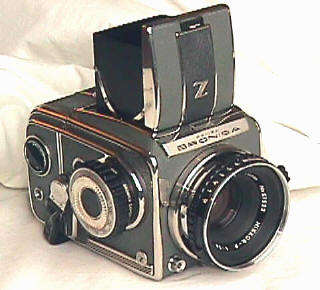
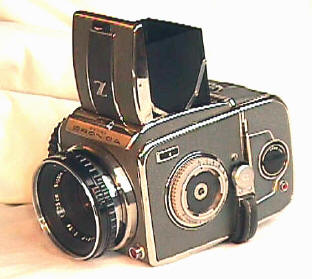
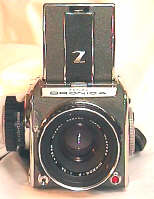
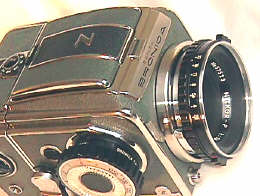
The shutter release is on the lower front right. The depth of field pre-view button is the red button on the left. Pushing the finder release button, just above the Bronica name plate, allows finder and focusing screen removal. The mirror is an unusual design. Instead of rising upward, it swings down and forward to permit the use of deeply recessed lenses.
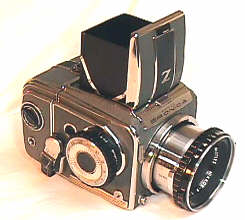
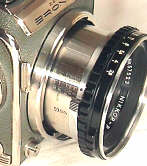
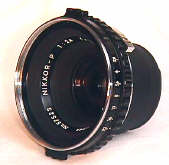
The focusing helical is built into the body, and extends a maximum of 18mm for close-ups. The bayonet lens release button is on the lens. The 75/2.8 Nikkor appears to be a shallow mounted on the camera, actually extends 42mm into the body. That lever on the front of the body locks the focusing helical.
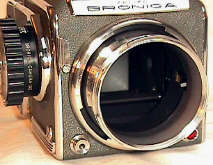
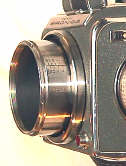
Focusing scales for the 50 and 135 lenses are engraved on the right and left side of the focusing helical, respectively.
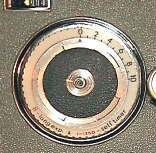
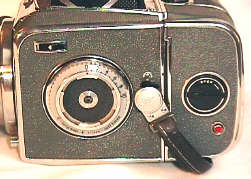
That funny dial marked 0 to 10 is actually the combination self timer/slow speed dial. To set the slow speed dial, set the high speed dial on the advance knob to B. Then push the black button above the slow speed dial forward, this will unlock the slow speed knob and allow you to turn it to your chosen slow speed. For the self timer, leave the high speed dial at 1 second or higher, and precede as before.
Notice the PC connection is in the center of the slow speed/self timer dial. Notice the bayonet mount for the separate non-coupled selenium exposure meter. Turning the black knob on the back marked "Open" after pushing in the little red button will strangely enough open the camera back for loading. Inserting a dark slide will automatically detach the back, a very nice touch.
Above the strap lug on the self timer side you will see what appears to be a button. Actually it is a slotted screw head, the famous de-jamming screw. If the camera jams up, turn it, and you will probably be just fine. Funny, I have been searching for years for a similar de-jamming screw on my own body, I guess I was the economy model.
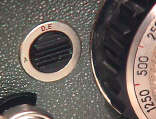
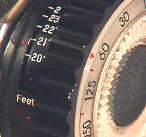
That button marked "DE" is for double exposure. The OUTSIDE of the focusing knob selects the high shutter speed, from 1 to 1/1250th. Turning the knob back and forth focuses the lens. PULLING the knob out and turning it advances the film and cocks the shutter.
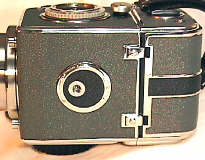
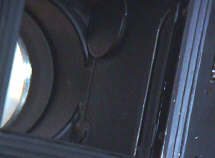
The bottom of the camera is just as beautifully made as the rest. Around the normal tripod socket is a special bayonet lug for a Bronica tripod mount. The film chamber is well finished, showing a maximum of light baffling.
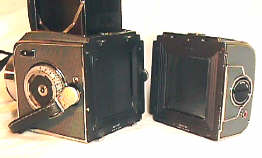
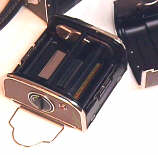
Hmm.. Looks like a case of Swedish envy to me. However, the Bronica has a cloth shutter curtain, unlike the early metal focal plane shutters of the Hasselblad 1600 and 1000.
My thanks to Robert Monaghan's wonderful Bronica site, and to Bronica super fan Michael Beard for their much appreciated help.
Quick Identification Points
The D or Deluxe is Bronica's second model, after the almost identical Bronica Z. Both are very rare, and very undervalued per standard price guides. Both have 1/1250th top speeds. The X flash setting is between 1/30th and 1/60th on the Z, between 1/1250th and B on the D's. There are actually two model D's. The D Type 1 starts with serial # CB21 while the D Type 2 starts with serial # ACB23. Serial numbers are visible on the back edge of the body, after you remove the back. Later Bronicas had the top speed reduced to 1/1000th.
Finders and backs ARE NOT interchangeable between the Z and D and the later Bronica S.
Home Camera Articles FOR SALE Orders I Buy / Wants Repairs Books Adapters
Revised: November 25, 2003 . Copyright � 1998- 2002 Stephen Gandy. All rights reserved. This means you may NOT copy and re-use the text or the pictures in ANY other internet or printed publication of ANY kind. Information in this document is subject to change without notice. Other products and companies referred to herein are trademarks or registered trademarks of their respective companies or mark holders.